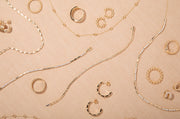For many people, a diamond is a diamond. A clear and radiant beauty, the forever bright spot that we could gaze at forever! Diamonds seem to have a magical, mesmerizing power no matter what. However, as your eye becomes more trained, you’ll begin to hone in on a diamond’s color. Color - when it comes to diamonds - refers to the degree to which it is “colorless.” Let’s break down the “4 C’s” and take an in-depth look at what it means to consider color when choosing a diamond. There are some fun facts amidst the sparkle!
Understanding the 4 C’s
Searching for the perfect diamond can be both exhilarating and overwhelming. Reputable jewelers, like Dana Rebecca Designs, make the process as straightforward as possible, which is why a guide to the 4 C’s is a great starting off point.
Carat
Carat is the most straightforward of the 4 C's. A carat is the unit of measurement for a diamond's weight. Carats are divided into 100 “points.” For example, a "fifty pointer" signifies a half-carat diamond (0.50 ct). Carat weight shouldn't be confused with karat, which is a term used to measure the purity of gold.
Clarity
The clarity of a diamond is the absence of inclusions and blemishes, both internally and externally. Inclusions, often unfairly called "flaws'' or "imperfections," are unique characteristics that give each diamond its distinct identity, much like a personal fingerprint. Natural diamonds, unlike diamond alternatives like lab grown diamonds, often possess these unique inclusions, adding to their distinct character and charm. For a more in-depth comparison, check out our blog on the differences between lab grown and natural diamonds.
The clarity grade takes into account the size, location, quantity, and nature of these features and how they affect the diamond's appearance.
Most diamonds in the world possess some level of imperfection. It's essential to remember that clarity grading is conducted under 10x magnification, rendering many imperfections invisible to the naked eye. Dana Rebecca Designs believes in balancing clarity with other characteristics of the diamond to find the perfect combination of the 4 C’s.
Cut
The cut of a diamond refers to its proportions and finish. A diamond’s cut is widely recognized as the primary factor affecting its value, as it brings the stone to life! A well-cut diamond displays symmetrical precision with ideal depth, table, crown, and pavilion angles, with a flawless finish. Expert craftsmanship enables light to gracefully travel into the diamond, reflecting off its facets before bouncing back out, creating its scintillation and dazzling brilliance. Keep in mind that polish and symmetry also contribute to the overall appeal of any diamond shape. A round diamond is the only shape that receives an actual “Cut Grade” by the GIA Gemological Institute of America (GIA).
Now, to the “C” that we’re spotlighting — COLOR!
The GIA Color Grading System- A GIA diamond is one that has been graded by the Gemological Institute of America (GIA) according to their diamond color grade standards used to determine diamond quality.
- GIA is an independent, nonprofit organization that conducts research about various gems while educating gem professionals.
What is The Diamond Color Scale?
The color of a diamond refers to the degree to which it is "colorless.” The Gemological Institute of America (GIA) color scale ranges from D to Z, with D being "colorless" and Z being noticeably warmer with a yellowish hue.
The chart is further broken down into five general categories:
- D-F is "colorless"
- G-J is "near-colorless"
- K-M is "faint"
- N-R is "very light"
- S-Z is “light"
Past Z color, there is an entirely different color spectrum that encompasses "fancy" color diamonds (think Canary Yellow). which has its These colored diamonds have their own scale and terms.
While many people think they should only look at diamonds in the D-E-F range, the truth is that the untrained eye usually cannot detect the difference between colorless and near-colorless diamonds without side-by-side comparisons. A well-cut diamond can often appear more colorless than it actually is allowing one to potentially consider lower colors.
Color Scale Offered by Dana Rebecca Designs Bridal
Dana Rebecca Designs Bridal offers an exquisite selection of diamonds ranging from E to J on the GIA color scale, ensuring a perfect match for every bride's dream ring. Here's a breakdown of each color grade:
Colorless Diamonds:
Colorless diamonds are the pinnacle of diamond quality, offering the purest and most brilliant sparkle. These diamonds represent the highest grades in diamond clarity and color grading. These grades are the most sought-after grades for diamond engagement rings or other diamond jewelry.
- E Color Diamond: Nearly identical to D, E color diamonds are exceptionally rare and display a bright, colorless appearance, ideal for a pristine and elegant look.
- F Color Diamond: Virtually indistinguishable from E by the naked eye, F color diamonds are also considered colorless, offering excellent value without compromising on beauty.
Near Colorless Diamond:
Near colorless diamonds are graded G, H, I, and J. These diamonds offer excellent value, as they appear colorless to the untrained eye but come at a more affordable price.
- G Color Diamond: G diamonds are near-colorless with a subtle warmth that is barely noticeable, making them a popular choice for those seeking a blend of quality and value.
- H Color Diamond: H diamonds exhibit a slight hint of warmth, yet remain near-colorless, offering a perfect balance of brilliance and affordability.
- I Color Diamond: I diamonds show a faint hint of color that is often difficult to detect, providing a great option for those wanting a beautiful diamond at a lower price point.
- J Color Diamond: J diamonds have a soft, warm tint that can add a unique charm, especially when set in yellow gold or rose gold, offering a distinctive and budget-friendly option.
Factors Affecting Diamond Color Perception
The following are things to consider as they can potentially make a diamond appear to be a better or a worse color.
- Shapes like round and emerald cuts can appear much whiter than their actual color if the diamond is cut properly.
- Oval and pear shapes don’t conceal color very well because the tone can concentrate in the tips of an oval or at the point of a pear shape.
- The angle at which the diamond is viewed. Diamonds are graded on their sides so the color can be assessed without the diamond’s brilliance being a distraction.
- The light in which a diamond is viewed.Natural light is always the best light for grading color!
- When grading color, it’s important to lay the diamond on a pure white background.
- The cut of the diamond. The cut can have a major impact on the perception of the diamond’s color. While a cut can’t change the diamond’s natural color, a well cut diamond can sometimes “face up” and look like a better color while a poorly cut diamond might produce the opposite effect.
- Diamond fluorescence can also alter color perception. Lower color diamonds with medium to strong fluorescence may actually appear as more colorless in natural light.
Benefits of Colorless Diamonds
D, E, F diamonds absolutely look more white - plain and simple.
Appeal of Near Colorless Diamonds
G, H, I, J diamonds are sold at a lower price point which might allow the buyer to increase the carat weight or achieve a better clarity by sacrificing some color.
Most Popular Diamond Colors for Engagement Rings
This is a tough question as it really comes down to one’s overall ring goals. It’s also very shape specific. DRD often sees:
- Round cut diamonds with G-H-I colors.
- Oval and radiant cut diamonds with E-F-G colors.
- Emerald cut diamonds with F-G-H colors.
How Diamond Color Affects Price
A diamond’s color is an important factor among the variety of characteristics that contribute to the price of a diamond. The DRD perspective is that a diamond’s color should be a careful quality consideration when buying a diamond.
Naturally, higher colors fetch premium prices while lower colors are less expensive. When considering what color is right for you, it’s important to first determine where color “ranks” in the hierarchy of quality characteristics.
How will sacrificing color or stepping up in color change what you can afford when it comes to the other characteristics?
Next, find the spot on the color spectrum where you’re comfortable with the level of colorlessness. Once that's determined, you should land on your ideal color.
It’s interesting how the 4 C’s truly work together when choosing a diamond. We love a system that helps make a very important choice slightly easier by breaking down the key factors. Diamonds really do exude a majestic energy — they’re endlessly fascinating! For more diamond education, check out the DRD blog!
Sources:
Gemological Institute of America. (n.d.). The 4Cs of diamond quality: Color. Retrieved June 24, 2024, from https://www.gia.edu/gia-about/4cs-color





